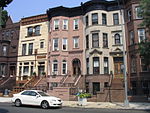Herbert Von King Park

Herbert Von King Park is an urban park in the Bedford–Stuyvesant neighborhood of Brooklyn in New York City. It was one the first parks established in Brooklyn, from land originally acquired in 1857. The park was originally named Tompkins Park, after former New York governor Daniel D. Tompkins, and was renamed in 1985 in honor of Herbert Von King, a longtime local community organizer who was nicknamed the "mayor of Bedford–Stuyvesant". The park is bounded on the north by Lafayette Avenue, to the east by Tompkins Avenue, to the south by Greene Avenue, and to the west by Marcy Avenue. The park contains a ballfield, a playground, and the Herbert Von King Cultural Arts Center, the latter of which opened in 1973. The facility also has the Almira Kennedy Coursey Ampitheatre, named after a longtime advocate for the facility's construction.
Excerpt from the Wikipedia article Herbert Von King Park (License: CC BY-SA 3.0, Authors, Images).Herbert Von King Park
Lafayette Avenue, New York Brooklyn
Geographical coordinates (GPS) Address Website Nearby Places Show on map
Geographical coordinates (GPS)
| Latitude | Longitude |
|---|---|
| N 40.689444444444 ° | E -73.946388888889 ° |
Address
Herbert Von King Cultural Arts Center
Lafayette Avenue 670
11216 New York, Brooklyn
New York, United States
Open on Google Maps




